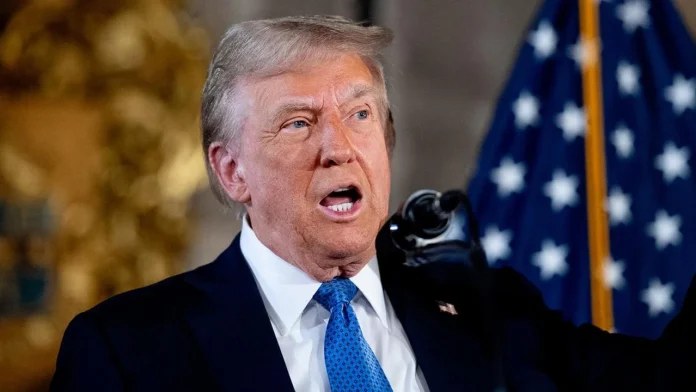In the aftermath of his re-election, President Donald Trump has escalated his confrontational stance toward the media, transitioning from mere criticism of outlets he perceives as hostile to implementing measures that actively curtail press freedoms. This represents a marked intensification of his ongoing struggle against journalists and media organizations that do not align with his narrative. What began as campaign rhetoric has now morphed into official policy, with the Trump administration taking definitive steps to restrict access to information, intimidate news organizations, and mold the media landscape to fit its agenda. Such actions have triggered alarm among advocates of press freedom, who caution that these developments threaten democratic principles and the public’s right to be informed.
A particularly alarming incident occurred on February 11, when reporters from the Associated Press (AP) were prohibited from covering White House events for two consecutive days. The reason behind this unprecedented action? The AP declined to adopt Trump’s newly minted term, “Gulf of America,” for the Gulf of Mexico. Despite an executive order renaming the body of water, the AP adhered to its established style guide, prompting White House Press Secretary Karoline Leavitt to defend the ban by stating, “It’s a privilege to cover the White House,” and questioning the reluctance of news outlets to embrace the new nomenclature.
This incident is emblematic of a broader pattern of targeting media organizations. At the Pentagon, several respected news outlets, including NBC News and National Public Radio (NPR), were removed from their designated workspaces as part of a newly instituted “annual media rotation program.” These spaces were subsequently allocated to far-right outlets such as One America News Network, known for its close ties to Trump and his allies. Renowned journalist Katie Couric criticized this maneuver, asserting it would impede journalists’ ability to cover the Pentagon effectively.
Moreover, the Federal Communications Commission (FCC), now under the leadership of Trump appointee Brendan Carr, has been weaponized against the press. Under Carr’s guidance, the FCC has initiated investigations into public broadcasters NPR and PBS regarding alleged commercial activities, which both organizations deny. Given that federal funding for these broadcasters hinges on their adherence to non-commercial content, these inquiries pose a potentially severe threat. Additionally, the FCC has reopened investigations into CBS and ABC, accusing them of “news distortion” and mishandling presidential debates.
The administration has also implemented measures to restrict public access to government information. Thousands of pages have been deleted from federal websites, including those of the Centers for Disease Control and Prevention (CDC) and the Environmental Protection Agency (EPA). Journalists have faced barriers to accessing White House pool reports, detailing the president’s daily activities, while pro-Trump propagandists, podcasters, and social media influencers have been granted credentials instead.
Clayton Weimers, Executive Director of Reporters Without Borders USA, condemned these actions, stating, “Coming into office and immediately deleting webpages, hiding government data, and interfering with journalists’ access sets a dangerous tone.” Legal threats have also been a significant tool in Trump’s anti-media arsenal. He has filed lawsuits against multiple outlets, including ABC News and CBS, over their coverage. In one notable case, ABC agreed to pay $15 million to settle a defamation lawsuit after anchor George Stephanopoulos referred to Trump as “found liable for raping” writer E. Jean Carroll. While a court determined Trump liable for sexual abuse, it did not rule on rape, leading to the legal contention.
Although Trump’s long-standing threat to amend libel laws to facilitate lawsuits against media organizations has not come to fruition—since libel laws fall under state jurisdiction—his rhetoric has created a chilling effect. Heidi Kitrosser, a constitutional law professor at Northwestern University, observed, “The mere threat of such action, backed by the power of the State, impinges on the ability of the press to report freely.”
Critics contend that these actions reflect a broader contempt for a free press. Rebecca Hamilton, a law professor at American University, articulated this sentiment, stating, “Their view is that any media outlets that don’t align themselves with Trump’s agenda are the enemy.” This perspective has led some to draw parallels between Trump’s tactics and fascism, a political ideology characterized by authoritarianism, suppression of dissent, and information control. While Hamilton refrained from explicitly labeling Trump as a fascist, she cautioned that his actions reflect “a fundamental disrespect for the principles underlying a democratic commitment to a free press.”
A commentator from Guyana remarked that, in a nation where freedom of expression is enshrined in the constitution, these developments serve as a stark reminder of the need to protect democratic values. As our nation strives to strengthen its institutions, the erosion of press freedoms elsewhere underscores the importance of vigilance. The media’s role as a watchdog, responsible for holding those in power accountable, remains crucial to the health of any democracy.
Trump’s maneuvers—ranging from barring journalists to launching investigations into media organizations—signify a profound shift from rhetoric to reality. As these measures unfold, the global community watches closely, aware that the implications extend far beyond the confines of the United States.


